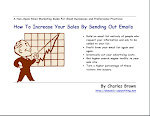6 Ways To Differentiate Your Business, Product or Service
Posted by Charles Brown at Monday, December 04, 2006In the past month, I’ve worked with several new clients who’ve had real difficulties differentiating their businesses, products and services.
It should be no surprise that finding ways to differentiate ourselves is such a struggle. We are bred to conformity, both in life and in business. But without a clear way to show potential customers and clients how we are different and how those differences can benefit them, we are just one fish in the pond.
I have learned that I can probe my clients with questions and bounce ideas off of them, but only they can find their own ways to differentiate.
Nevertheless, it is a daunting task to be expected to write copy for someone who can’t tell me how to distinguish him or her from all their competitors (I’ve never felt good about turning in copy that just relies on cute phrases or basically says, “we’re the best”).
Here are some ideas to help you find ways to distinguish your business, service or product from all the others out there:
- What emotions do you want to appeal to? Fear and anxiety are always the strongest emotions to tap into, but greed, ambition, safety, financial security, love for family, etc. are always solid winners to be put on this list.
- If you are having difficulty differentiating yourself, think about how you would like to position your competitors. When M&Ms says they “melt in your mouth, not in your hands,” they are in effect saying that all other chocolate candies melt in your hands and leave a sticky mess. Think about how you would like your potential customers to think about your competitors and then show how you are different.
- What are your benefits? You had to know that any article on marketing had to get around to benefits eventually. List out your benefits and build on them. In all likelihood, at least one item on your list will trigger a chord with you. It may not matter that all your competitors also offer this benefit, as long as they aren’t building their message upon that benefit.
- What problems does your business, product or service solve? As you write out this list, you will probably find a lot of overlap with the benefits list, but don’t worry. Solutions are really just another way to look at benefits. But writing this list forces you to look at what you do from the customers’ point of view.
- Although claims that your product or service is “better” usually sounds hollow, sometimes it works anyway. But a “better” strategy will take a lot of work to sound convincing to your customers’ ears. If being better is really important to the people who buy what you sell, go for it.
But if you go down this road, you had better have a lot of proof. Gather customer testimonies, industry data and independent third party endorsements to support your claim to being better.
Reality check: If you are the new kid on the block, don’t even try to claim you are the best. If your business or your product or your service is new, you simply aren’t the best. You have no proof to offer and trying to make this claim when you are new will kill your credibility. - Be new. I’m not contradicting the last item on this list when I say “be new,” I am saying to innovate. Invent a new product, invent a new way to use an existing product, invent a new solution to an old problem or find a way to serve a new type of customer with your existing product or service. If you can be cutting edge, you can create your own niche and everyone else will be scrambling to keep up.
Once you find a way to differentiate yourself from all the others out there, your message becomes much easier to convey. More to the point, it becomes easier for your potential customers to hear and understand.
Differentiation is how you can cut through all the noise and clutter that bombard your customers everyday.
COPYRIGHT © 2006, Charles Brown




0 comments:
Post a Comment